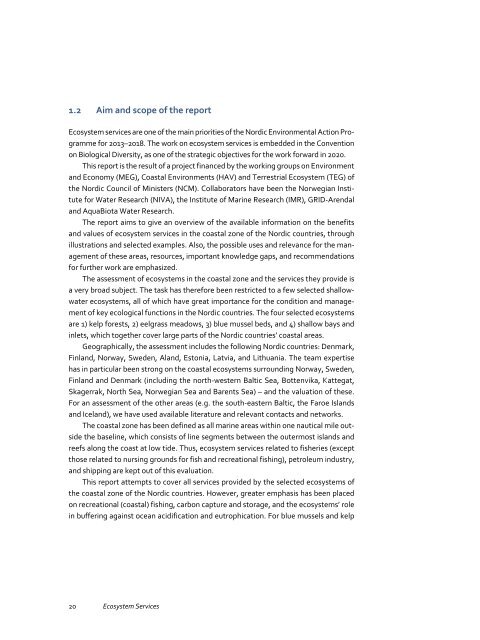Ecosystem Services
FULLTEXT01
FULLTEXT01
Create successful ePaper yourself
Turn your PDF publications into a flip-book with our unique Google optimized e-Paper software.
1.2 Aim and scope of the report<br />
<strong>Ecosystem</strong> services are one of the main priorities of the Nordic Environmental Action Programme<br />
for 2013–2018. The work on ecosystem services is embedded in the Convention<br />
on Biological Diversity, as one of the strategic objectives for the work forward in 2020.<br />
This report is the result of a project financed by the working groups on Environment<br />
and Economy (MEG), Coastal Environments (HAV) and Terrestrial <strong>Ecosystem</strong> (TEG) of<br />
the Nordic Council of Ministers (NCM). Collaborators have been the Norwegian Institute<br />
for Water Research (NIVA), the Institute of Marine Research (IMR), GRID-Arendal<br />
and AquaBiota Water Research.<br />
The report aims to give an overview of the available information on the benefits<br />
and values of ecosystem services in the coastal zone of the Nordic countries, through<br />
illustrations and selected examples. Also, the possible uses and relevance for the management<br />
of these areas, resources, important knowledge gaps, and recommendations<br />
for further work are emphasized.<br />
The assessment of ecosystems in the coastal zone and the services they provide is<br />
a very broad subject. The task has therefore been restricted to a few selected shallowwater<br />
ecosystems, all of which have great importance for the condition and management<br />
of key ecological functions in the Nordic countries. The four selected ecosystems<br />
are 1) kelp forests, 2) eelgrass meadows, 3) blue mussel beds, and 4) shallow bays and<br />
inlets, which together cover large parts of the Nordic countries’ coastal areas.<br />
Geographically, the assessment includes the following Nordic countries: Denmark,<br />
Finland, Norway, Sweden, Aland, Estonia, Latvia, and Lithuania. The team expertise<br />
has in particular been strong on the coastal ecosystems surrounding Norway, Sweden,<br />
Finland and Denmark (including the north-western Baltic Sea, Bottenvika, Kattegat,<br />
Skagerrak, North Sea, Norwegian Sea and Barents Sea) – and the valuation of these.<br />
For an assessment of the other areas (e.g. the south-eastern Baltic, the Faroe Islands<br />
and Iceland), we have used available literature and relevant contacts and networks.<br />
The coastal zone has been defined as all marine areas within one nautical mile outside<br />
the baseline, which consists of line segments between the outermost islands and<br />
reefs along the coast at low tide. Thus, ecosystem services related to fisheries (except<br />
those related to nursing grounds for fish and recreational fishing), petroleum industry,<br />
and shipping are kept out of this evaluation.<br />
This report attempts to cover all services provided by the selected ecosystems of<br />
the coastal zone of the Nordic countries. However, greater emphasis has been placed<br />
on recreational (coastal) fishing, carbon capture and storage, and the ecosystems’ role<br />
in buffering against ocean acidification and eutrophication. For blue mussels and kelp<br />
20 <strong>Ecosystem</strong> <strong>Services</strong>


